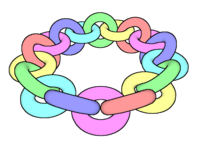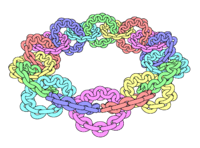Antoine's necklace


In mathematics, Antoine's necklace, discovered by Louis Antoine (1921), is a topological embedding of the Cantor set in 3-dimensional Euclidean space, whose complement is not simply connected.
Construction
Antoine's necklace is constructed iteratively like so: Begin with a solid torus A0 (iteration 0). Next, construct a "necklace" of smaller, linked tori that lie inside A0. This necklace is A1 (iteration 1). Each torus composing A1 can be replaced with another smaller necklace as was done for A0. Doing this yields A2 (iteration 2).
This process can be repeated a countably infinite number of times to create an An for all n. Antoine's necklace A is defined as the intersection of all the iterations.
Properties
Since the solid tori are chosen to become arbitrarily small as the iteration number increases, the connected components of A must be single points. It is then easy to verify that A is closed, dense-in-itself, and totally disconnected, having the cardinality of the continuum. This is sufficient to conclude that A is homeomorphic to the Cantor set.
Antoine's necklace was used by Alexander (1924) to construct Antoine's horned sphere (similar to but not the same as Alexander's horned sphere).
See also
References
- Antoine, Louis (1921), "Sur l'homeomorphisme de deux figures et leurs voisinages", Journal Math Pures et appl. 4: 221–325
- Alexander, J. W. (1924), "Remarks on a Point Set Constructed by Antoine", Proceedings of the National Academy of Sciences of the United States of America 10 (1): 10–12, doi:10.1073/pnas.10.1.10, JSTOR 84203, PMC 1085501, PMID 16576769
- Brechner, Beverly L.; Mayer, John C. (1988), "Antoine's Necklace or How to Keep a Necklace from Falling Apart", The College Mathematics Journal 19 (4): 306–320, doi:10.2307/2686463, JSTOR 2686463